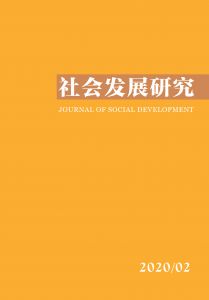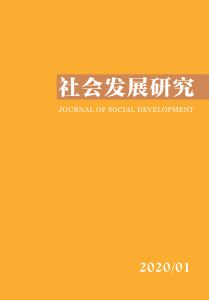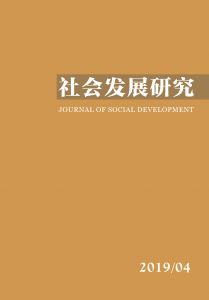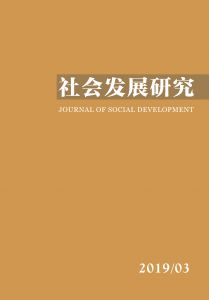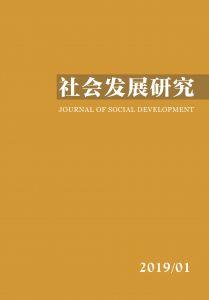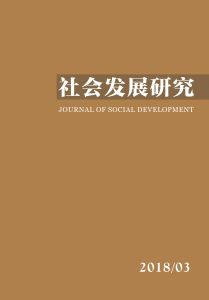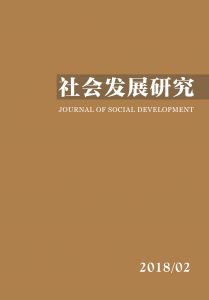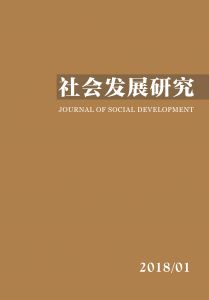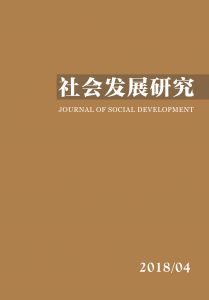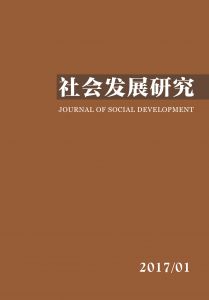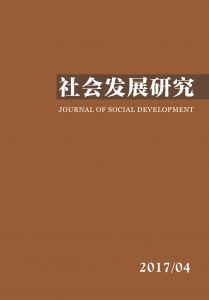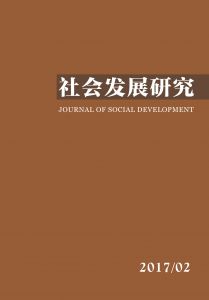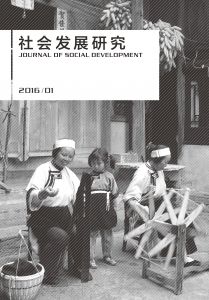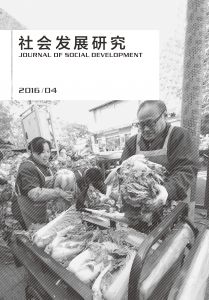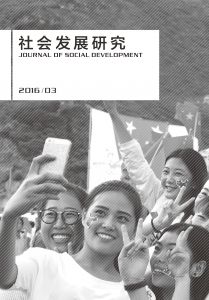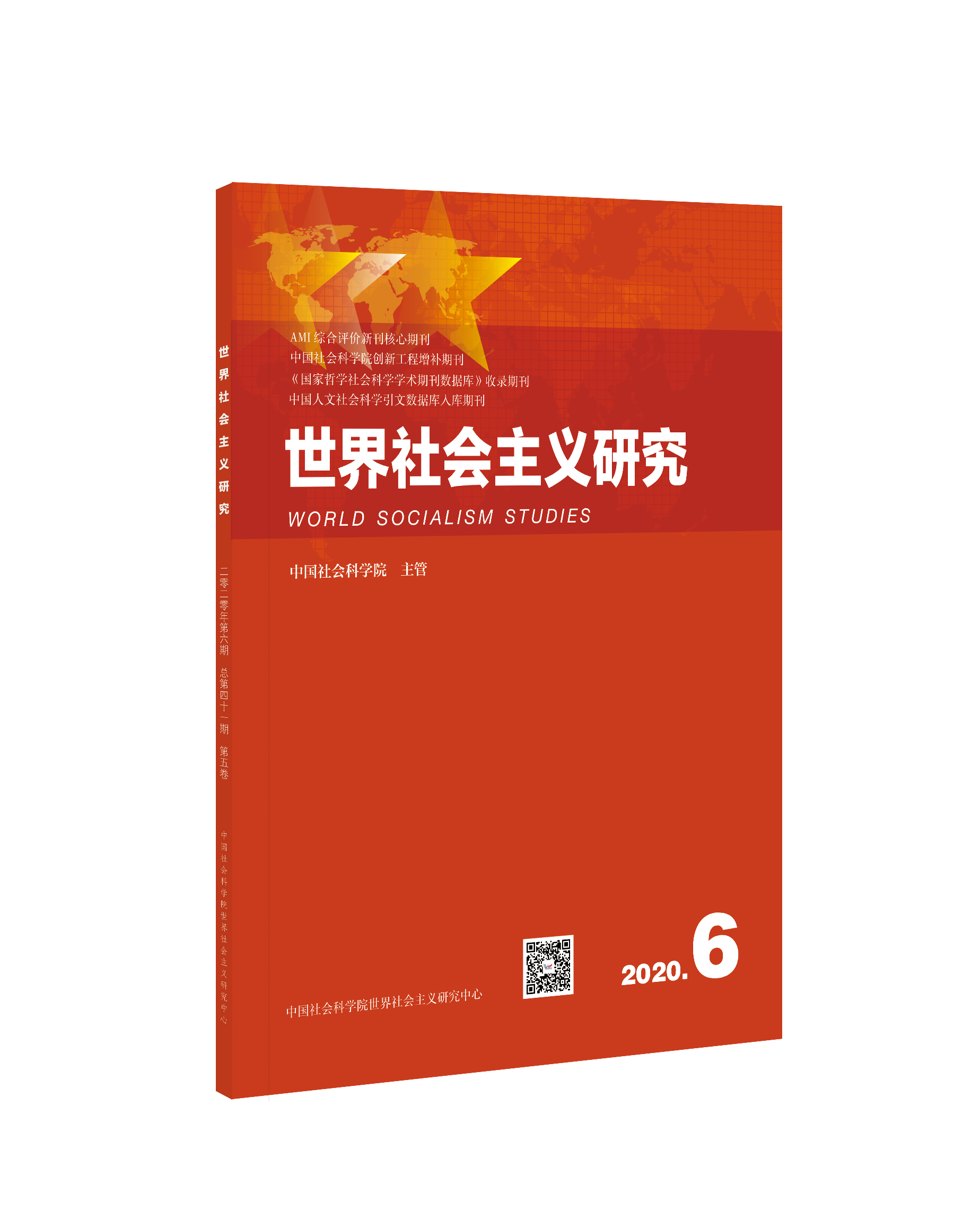最新期刊
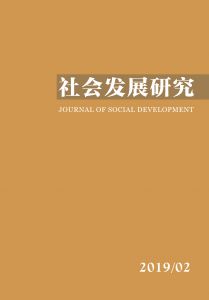
目录
过往期刊
参考文献
-
编委会
-
·马克思主义学习与研究专栏·
-
后增长理念与集体再造
-
资本监管与工人劳动自主性
-
-
·专题研究· 儿童发展
-
教养方式对儿童学业能力的影响
-
美国儿童保护强制报告制度响应模式的新转向及其对中国的启示
-
-
·论文·
-
社会网络类型与老年人幸福感
-
缅甸人心目中的中国人:社会距离及其影响因素
-
理性化:教育水平对社会信任的发展与调节效应
-
客观“获得”与主观“获得感”
-
乡土社会的日常道德与社会底蕴
-
居住隔离与流动人口精神健康研究
-
-
·调查报告·
-
中国校车服务:问题、经验借鉴与治理
-
-
·书评·
-
阿瑞吉的经济社会学研究:金融化与资本积累的系统周期
-
政治文化如何塑造产业政策?
-
-
英文目录及摘要
-
稿约
-
更正说明
-
版权页
按年份浏览:
- 全部
- 2020
- 2019
- 2018
- 2017
- 2016
- 2015
- 2014
[1][1]陈国富、卿志琼,2009,《财政幻觉下的中国土地财政:一个法经济学视角》,《南开学报》(哲学社会科学版)第1期。
[2][2]陈晓军、李文君,2016,《“村改居”背景下集体经济组织发展与改革研究——基于广东和山东两省的实地调研》,《中国农村研究》第2期。
[3][3]陈映芳,2008,《城市开发的正当性危机与合理性空间》,《社会学研究》第3期。
[4][4]陈映芳,2012,《城市与中国社会研究》,《社会科学》第10期。
[5][5]崔香芬、赵淑华,2014,《中青年被征地农民养老保障参与意愿实证分析——基于江苏6市的调研》,《经济体制改革》第6期。
[6][6]杜国明,2011,《“村改居”后农村集体经济组织面临的新问题探讨——基于广东省的调研分析》,《农村经济》第8期。
[7][7]何·皮特,2008,《谁是中国土地的拥有者?——制度变迁、产权和社会冲突》,林韵然译,北京:社会科学文献出版社。
[8][8]户邑、彭小兵,2005,《城市拆迁管理过程中利益共同体的合谋行为研究》,《长春大学学报》第3期。
[9][9]黄荣贵、郑雯、桂勇,2015,《多渠道强干预、框架与抗争结果——对40个拆迁抗争案例的模糊集定性比较分析》,《社会学研究》第5期。
[10][10]贾国强,2018,《2017年全国300城市土地出让金超4万亿元》,《中国经济周刊》第3期。
[11][11]刘成斌,2014,《盆景主义及其超越:田野调查中理论与经验的关系问题》,《华中科技大学学报》(社会科学版)第3期。
[12][12]刘守英、邵挺,2013,《告别“以地谋发展”》,《中国改革》第6期。
[13][13]卢福营,2017,《城中村改造:一项系统的新型城镇化工程》,《社会科学》第10期。
[14][14]骆祖春,2012,《中国土地财政问题研究》,南京大学博士学位论文。
[15][15]覃琮,2013,《农民维权活动的理法抗争及其理论解释——两起征地案例的启示》,《社会》第6期。
[16][16]渠敬东,2019,《迈向社会全体的个案研究》,《社会》第1期。
[17][17]施芸卿,2014,《增长与道义》,《社会学研究》第6期。
[18][18]孙秀林、周飞舟,2013,《土地财政与分税制——一个实证解释》,《中国社会科学》第4期。
[19][19]仝志辉、韦潇竹,2019,《通过集体产权制度改革理解乡村治理:文献评述与研究建议》,《四川大学学报》(哲学社会科学版)第1期。
[20][20]王颖,1996,《新集体主义:乡村社会的再组织》,北京:经济管理出版社。
[21][21]余靖雯、肖洁、龚六堂,2015,《政治周期与地方政府土地出让行为》,《经济研究》第2期。
[22][22]张静,2003,《土地使用规则的不确定:一个解释框架》,《中国社会科学》第1期。
[23][23]赵定东、袁丽丽,2016,《村改居居民的社会保障可持续性困境分析》,《浙江社会科学》第12期。
[24][24]庄蕊萌、宋明爽,2017,《“镇改街道”进程中农村集体资产产权处置的个案研究》,《山东农业大学学报》(社会科学版)第2期。
[25][25]周怡,2005,《共同体整合的制度环境:惯习与村规民约——H村个案研究》,《社会学研究》第6期。
[26][26]周怡,2006,《寻求整合的分化:权力关系的独特作用——来自H村的一项经验研究》,《社会学研究》第5期。
[27][27]Andreas,Joel & Shaohua Zhan 2016,“Hukou and Land:Market Reform and Rural Displacement in China.” The Journal of Peasant Studies ,43(3).
[28][28]Chuang,Julia 2015,“Urbanization through Dispossession:Survival and Stratification in China’s New Townships.” The Journal of Peasant Studies ,42(2).
[29][29]Hsing,You-tien 2010,The Great Urban Transformation:Politics of Land and Property in China . Oxford:Oxford University Press.
[30][30]Looney,Kristen & Meg Rithmire 2016,“Urbanization with Chinese Characteristics?China’s Gamble for Modernization.” Harvard Business School Working Paper.
[31][31]Oi,Jean C.1992,“Fiscal Reform and the Economic Foundations of Local State Corporatism in China.” World Politics ,45(1).
[32][32]Qian,Yingyi & Barry R.Weingast 2011,“China’s Transition to Markets:Market-Preserving Federalism,Chinese Style.” Journal of Economic Policy Reform ,1(2).
[33][33]Zhan,Shaohua 2017,“Hukou Reform and Land Politics in China:Rise of A Tripartite Alliance.” The China Journal ,(78).
[34][34]布雷弗曼,1979,《劳动与垄断资本》,方生、朱基俊、吴忆宣、陈卫、张其骈译,张伯健校,北京:商务印书馆。
[35][35]蔡禾、李超海、冯建华,2009,《利益受损农民工的利益抗争行为研究——基于珠三角企业的调查》,《社会学研究》第1期。
[36][36]何明洁,2009,《劳动与姐妹分化——“和记”生产政体个案研究》,《社会学研究》第2期。
[37][37]李芏巍,2015,《快递来了》,北京:中国铁道出版社。
[38][38]梁萌,2016,《技术变迁视角下的劳动过程研究——以互联网虚拟团队为例》,《社会学研究》第2期。
[39][39]刘爱玉,2017,《制度、结构与农民工行动选择机会的形塑——以长三角地区服装业为例》,《江苏行政学院学报》第6期。
[40][40]马冬玲,2010,《情感劳动——研究劳动性别分工的新视角》,《妇女研究论丛》第3期。
[41][41]马克思,2004,《资本论.第一卷》,北京:人民出版社。
[42][42]潘毅、卢晖临、张慧鹏,2010,《阶级的形成:建筑工地上的劳动控制与建筑工人的集体抗争》,《开放时代》第5期。
[43][43]施芸卿,2016,《制造熟客:劳动过程中的情感经营——以女性美容师群体为例》,《学术研究》第7期。
[44][44]苏熠慧,2011,《控制与抵抗:雇主与家政工在家务劳动过程中的博弈》,《社会》第6期。
[45][45]汪建华,2011,《互联网动员与代工厂工人集体抗争》,《开放时代》第11期。
[46][46]汪建华、孟泉,2013,《新生代农民工的集体抗争模式——从生产政治到生活政治》,《开放时代》第1期。
[47][47]闻翔、周潇,2007,《西方劳动过程理论与中国经验:一个批判性的述评》,《中国社会科学》第3期。
[48][48]赵炜,2012,《“双重特殊性”下的中国建筑业农民工——对于建筑业劳动过程的分析》,《经济社会体制比较》第5期。
[49][49]Blauner,Robert 1964,Alienation and Freedom:The Factory Worker and His Industry . Chicago:University of Chicago Press.
[50][50]Burawoy,Michael 1982,Manufacturing Consen . Chicago:University of Chicago Press.
[51][51]Callaghan,George & Paul Thompson 2000,“Edwards Revised:Technical Control and Call Centres,” Open Discussion Papers in Economics 25,The Open University,Faculty of Social Sciences,Department of Economics.
[52][52]Elliott,Christopher & Long Gary 2015,“Manufacturing Rate Busters:Computer Control and Social Relations in the Labour Process”. Work Employment & Society 30(1).
[53][53]Hochschild,Arlie Russell 2012,Managed Heart . Berkeley:University of California.
[54][54]Leidner,Robin 1993,Fast Food,Fast Talk . Berkeley:University of California Press.
[55][55]Wright,Erik Olin 2000,“Working-Class Power,Capitalist-Class Interests,and Class Compromise.” American Journal of Sociology (4).
[56][56]Zuboff,Shoshana 1988,In the Age of Smart Machine . New York:Basic Books.
[57][57]方平、熊端琴、郭春彦,2003,《父母教养方式对子女学业成就影响的研究》,《心理科学》第1期。
[58][58]雷雳、张钦、侯志瑾,2001,《学习不良初中生的父母教养方式及其自我概念》,《心理科学》第2期。
[59][59]李敏、甘怡群,2011,《高中生学业倦怠倾向与父母教养方式的关系分析》,《中国学校卫生》第1期。
[60][60]罗云、陈爱红、王振宏,2016,《父母教养方式与中学生学业倦怠的关系:自我概念的中介作用》,《心理发展与教育》第1期。
[61][61]马雪玉,2015,《父母教养方式和学业拖延对小学生学业水平影响的路径分析》,《中国学校卫生》第12期。
[62][62]王丽、傅金芝,2005,《国内父母教养方式与儿童发展研究》,《心理科学进展》第3期。
[63][63]杨青松、石梦希、舒思,2017,《初中生学业拖延与家庭教养方式、成就动机的关系》,《中国临床心理学杂志》第3期。
[64][64]杨振宇、张程,2017,《东迁、自选择与劳动力溢价:“孔雀东南飞”背后的故事》,《经济学(季刊)》第4期。
[65][65]Barber,B.K. & M. Xia 2013,“The Centrality of Control to Parenting and Its Effects”,In R. E. Larzelere,A. S. Morris,& A. W. Harrist(eds.),Authoritative Parenting:Synthesizing Nurturance and Discipline for Optimal Child Development . Washington,DC:American Psychological Association.
[66][66]Baumrind,D. 1971,“Current Patterns of Parental Authority.” Developmental Psychology 4(1p2).
[67][67]Belsky,J. 1984,“The Determinants of Parenting:A Process Model.” Child Development 55(1).
[68][68]Bernal,R. & M.P. Keane 2011,“Child Care Choices and Children’s Cognitive Achievement:The Case of Single Mothers.” Journal of Labor Economics 29(3).
[69][69]Blake,J. 1989,Family Size and Achievement . Los Angeles,CA:University of California Press.
[70][70]Blau P. M. & Duncan O. D. 1967,The American Occupational Structure . Hoboken,NJ:John Wiley & Sons Inc.
[71][71]Bono,E. D.,M. Francesconi,Y. Kelly,& A. Sacker 2016,“Early Maternal Time Investment and Early Child Outcomes.” The Economic Journal 126(596).
[72][72]Bornstein,M. 2006,“Parenting Science and Practice.” In Damon,W.,& R.M. Lerner(eds.)Handbook of Child Psychology . Hoboken,NJ:John Wiley & Sons.
[73][73]Bornstein,M. 2015,“Children’s Parents” In Lerner R.M.(ed.)Handbook of Child Psychology and Developmental Science:Ecological Settings and Processes . Hoboken,NJ:John Wiley & Sons.
[74][74]Bowers,E. P.,S. Gestsdottir,G. J. Geldhof,J. Nikitin,A. Von Eye,& R.M. Lerner 2011,“Developmental Trajectories of Intentional Self-Regulation In Adolescence:The Role of Parenting and Implications for Positive and Problematic Outcomes Among Diverse Youth.” Journal of Adolescence 34(6).
[75][75]Cattaneo,M. D. 2010,“Efficient Semiparametric Estimation of Multi-Valued Treatment Effects under Ignorability.” Journal of Econometrics 155(2).
[76][76]Chan,T. W. & A. Koo 2011,“Parenting Style and Youth Outcomes in the UK.” European Sociological Review 27(3).
[77][77]Chao,R. K. 1994,“Beyond Parental Control and Authoritarian Parenting Style:Understanding Chinese Parenting through the Cultural Notion of Training.” Child Development 65(4).
[78][78]Chao,R. K. 2001,“Extending Research on the Consequences of Parenting Style for Chinese Americans and European Americans.” Child Development 72(6).
[79][79]Chen,X.,Y. Bian,T. Xin,L. Wang & R.K. Silbereisen 2010,“Perceived Social Change and Childrearing Attitudes in China.” European Psychologist 15(4).
[80][80]Chen,X. & H. Chen 2010,“Children’s Socioemotional Functioning and Adjustment in the Changing Chinese Society.” In Silbereisen,R.K.(ed.)Social Change and Human Development:Concept and Results. London:Sage.
[81][81]Collins,W.A.,L.Steinberg,2008,“Adolescent Development in Interpersonal Context.” In Damon,W.,R.M.Lerner,W.Damon. & N. Eisenberg(eds.)Child and Adolescent Development:An Advanced Course Hoboken ,NJ:John Wiley & Sons.
[82][82]Cooper,H.,B. Nye,K. Charlton,J. Lindsay & S. Greathouse 1996,“The Effects of Summer Vacation on Achievement Test Scores:A Narrative and Meta-Analytic Review.” Review of Educational Research 66(3).
[83][83]Darling,N. & L. Steinberg 1993,“Parenting Style as Context:An Integrative Model.” Psychological Bulletin 113(3).
[84][84]Del Boca,D.,C. Flinn & M. Wiswall 2014,“Household Choices and Child Development.” The Review of Economic Studies 81(1).
[85][85]Dornbusch,S.M.,P.L. Ritter,P.H. Leiderman,D.F. Roberts & M.J. Fraleigh 1987,“The Relation of Parenting Style to Adolescent School Performance.” Child Development 58(5).
[86][86]Garcia,F. & E. Gracia 2009,“Is Always Authoritative The Optimum Parenting Style?Evidence From Spanish Families.” Adolescence 44(173).
[87][87]Gracia,P. 2014,“Fathers’ Child Care Involvement and Children’s Age in Spain:A Time Use Study on Differences by Education and Mothers’ Employment.” European Sociological Review 30(2).
[88][88]Graf,S. C,R. L. Mullis & A. K. Mullis 2008,“Identity formation of United States American and Asian Indian Adolescents.” Adolescence 43(169).
[89][89]Griliches,Z. & W. M. Mason 1972,“Education,Income,and Ability.” Journal of Political Economy 80(3,Part 2).
[90][90]Grusec,J. E.,D. Rudy & T. Martini 1997,“Parenting Cognitions and Child Outcomes:An Overview and Implications for Children’s Internalization of Values.” In J. E. Grusec & L. Kuczynski(eds.),Parenting and Children’s Internalization of Values:A Handbook of Contemporary Theory . New York,NY:Wiley.
[91][91]Harding,J.F.,P.A. Morris & D. Hughes 2015,“The Relationship between Maternal Education and Children’s Academic Outcomes:A Theoretical Framework.” Journal of Marriage and Family 77(1).
[92][92]Heckman,J. J. 2006,“Skill Formation and the Economics of Investing in Disadvantaged Children.” Science 312(5782).
[93][93]Hill,N.E. & D.F. Tyson 2009,“Parental Involvement in Middle School:A Meta-Analytic Assessment of the Strategies That Promote Achievement.” Developmental Psychology 45(3).
[94][94]Hindin,M.J. 2005,“Family Dynamics,Gender Differences and Educational Attainment in Filipino Adolescents.” Journal of Adolescence 28(3).
[95][95]Ho,D. YF 1986,“Chinese patterns of socialization:A critical review.” In M. H. Bond(ed.)The Psychology of the Chinese People. New York,NY:Oxford University Press.
[96][96]Kalil,A.,R. Ryan & M. Corey 2012,“Diverging Destinies:Maternal Education and the Developmental Gradient in Time with Children.” Demography 49(4).
[97][97]Kaushal,N.,K. Magnuson & J. Waldfogel 2011,“How Is Family Income Related to Investments in Children’s Learning?” In G. J. Duncan,& R. Murnane(eds.)Whither Opportunity?Rising Inequality,Schools,and Children’s Life Chances . New York,NY:Russell Sage Foundation.
[98][98]Kim,K. & R.P. Rohner 2002,“Parental Warmth,Control,and Involvement in Schooling:Predicting Academic Achievement among Korean American Adolescents.” Journal of Cross-Cultural Psychology 33(2).
[99][99]Lamborn,S.D.,N.S. Mounts,L. Steinberg & S.M. Dornbusch 1991,“Patterns of Competence and Adjustment among Adolescents from Authoritative,Authoritarian,Indulgent,and Neglectful Families.” Child Development 62(5).
[100][100]Lee,V.E. & D.T. Burkam 2002,Inequality at The Starting Gate:Social Background Differences In Achievement As Children Enter School . Washington,DC:Economic Policy Institute.
[101][101]Maccoby,E. E. & Martin J. A. 1983. “Socialization In The Context of The Family:Parent-Child Interaction”,In Paul H. Mussen(ed.),Handbook of Child Psychology:Vol. 4.Socialization,Personality,and Social Development.” New York,NY:Wiley.
[102][102]Majumder,M. A. 2016,“The Impact of Parenting Style on Children’s Educational Outcomes in the United States.” Journal of Family and Economic Issues 37(1).
[103][103]Martínez,I. & J.F. García 2007,“Impact of Parenting Styles on Adolescents’ Self-Esteem and Internalization of Values in Spain.” The Spanish Journal of Psychology 10(2).
[104][104]McLanahan S. & G. Sandefur 1994. Growing Up with A Single Parent. What Hurts,What Helps . Cambridge,MA:Harvard University Press.
[105][105]Moilanen,K. L. 2007,“The Adolescent Self-Regulatory Inventory:The Development and Validation of a Questionnaire of Short-Term and Long-Term Self-Regulation.” Journal of Youth and Adolescence 36(6).
[106][106]Murnane,R. J. 1975,The Impact of School Resources On Inner-City School Children . Cambridge,MA:Ballenger.
[107][107]Newman,B. M. & P.R. Newman 2015,Development through Life:A Psychosocial Approach. Stamford,CT:Cengage Learning.
[108][108]Papalia,D. E.,R. D. Feldman & G. Martorell 2015,Experience Human Development. New York,NY:McGraw-Hill Education.
[109][109]Pellerin,L.A. 2005,“Applying Baumrind’s Parenting Typology to High Schools:toward A Middle-Range Theory of Authoritative Socialization.” Social Science Research 34(2).
[110][110]Pong,S.,L. Hao & E. Gardner 2005,“The Roles of Parenting Styles and Social Capital in the School Performance of Immigrant Asian and Hispanic Adolescents.” Social Science Quarterly 86(4).
[111][111]Reigadas,E.T. 2006,An Ecological Systems Analysis of Eighth Grade Latino Students’ Academic Achievement. ProQuest.
[112][112]Rubin,D.B. 2001,“Using Propensity Scores to Help Design Observational Studies:Application to The Tobacco Litigation.” Health Services and Outcomes Research Methodology 2(3-4).
[113][113]Santrock,J.W. 2011,Life-Span Development . New York,NY:McGraw-Hill Education.
[114][114]Shek,DTL 2008,Predictors of Perceived Satisfaction with Parental Control In Chinese Adolescents:A 3-Year Longitudinal Study. Adolescence 43(169).
[115][115]Sigel,I.E. & A.V. McGillicuddy-De Lisi 2002,“Parenting Beliefs Are Cognitions:The Dynamic Belief Systems Model” In Bornstein M. H. Handbook of Parenting:Being and Becoming A Parent . Mahwah,NJ:Lawrence Erlbaum Associates,Inc. Publishers.
[116][116]Singh,K.,P. G.Bickley,P.Trivette & T. Z. Keith 1995,“The Effects of Four Components of Parental Involvement on Eighth-Grade Student Achievement:Structural Analysis of NELS-88 Data.” School Psychology Review 24(2).
[117][117]Stattin,H. & M. Kerr 2000,“Parental Monitoring:A Reinterpretation.” Child Development 71(4).
[118][118]Steinberg L.2014. Age of Opporiunity:Lessons from the New Science of Adolescence. Boston,MA:Houghton Mifflin Harcoun.
[119][119]Steinberg,L.,S.D. Lamborn & N. Darling 1994,“Over-Time Changes in Adjustment and Competence among Adolescents from Authoritative,Authoritarian,Indulgent,and Neglectful Families.” Child Development 65(3).
[120][120]Steinberg,L.,S.D. Lamborn,S.M. Dornbusch & N. Darling 1992,“Impact of Parenting Practices on Adolescent Achievement:Authoritative Parenting,School Involvement,and Encouragement to Succeed.” Child Development 63(5).
[121][121]Van Petegem,S.,W. Beyers,M. Vansteenkiste & B. Soenens 2012,“On the Association between Adolescent Autonomy and Psychosocial Functioning:Examining Decisional Independence from A Self-Determination Theory Perspective.” Developmental Psychology 48(1).
[122][122]Waldfogel,J. 2006,What Children Need. Cambridge,MA:Harvard University Press.
[123][123]Wang,H. 2014,“The Relationship between Parenting Styles and Academic and Behavioral Adjustment Among Urban Chinese Adolescents.” Chinese Sociological Review 46(4).
[124][124]祁占勇、王艺鑫,2018,《国外虐童行为治理的法律透视》,《比较教育研究》第10期。
[125][125]谢娜、蔡迎旗,2017,《家庭暴力受害儿童的求助及其承接问题研究》,《当代青年研究》第2期。
[126][126]云南省玉溪妇联,2018,《三级预防机制编织儿童保护“安全网”》,《中国妇运》第7期。
[127][127]Bartholet,Elizabeth 2015,“Differential Response:A Dangerous Experiment in Child Welfare.” Florida State University Law Review 42.
[128][128]Child Welfare Information Gateway 2014,“Differential Response to Reports of Child Abuse and Neglect.”(https://www.childwelfare.gov/pubs/issue-briefs/differential-response/Washington),DC:U.S.Department of Health and Human Services,Children’s Bureau.
[129][129]Child Welfare Information Gateway 2018,“Child abuse and neglect fatalities 2016:Statistics and interventions”,(https://www.childwelfare.gov/pubs/factsheets/fatality/Washington),DC:U.S.Department of Health and Human Services,Children’s Bureau.
[130][130]Godsoe,Cynthia 2012. “Just Intervention:Differential Response in Child Protection.” Journal of Law and Policy 21.
[131][131]Hughes,C.Ronald,Judith S.Rycus,Stacey M.Saunders-Adams,Laura K.Hughes & Kelli N.Hughes 2013,“Issues in Differential Response.” Research on Social Work Practice (September).
[132][132]Hughes,C.Ronald & Frank Vandervort 2016,“Differential Response:A Misrepresentation of Investigation and Case Fact Finding in Child Protective.” APSAC Advisor 28.
[133][133]Kaplan,C. & L.Merkel-Holguin 2008,“Another Look at The National Study on Differential Response in Child Welfare.” Protecting Children 23.
[134][134]Merkel-Holguin,Lisa,Kaplan Caren & Alina Kwak 2006,“National Study on Differential Response in Child Welfare.” Englewood,CO:American Humane Association and Child Welfare League of America.
[135][135]Piper,A.Kathryn 2016,“Differential Response in Child Protection:How Much is Too Much?” APSAC Advisor 28.
[136][136]Schene,Patricia 2001,“Meeting Each Family’s Needs:Using Differential Response in Reports of Child Abuse and Neglect.” Best Practice/Next practice,Family-Centered Child Welfare.
[137][137]Schene,Patricia 2005,“The Emergence of Differential Response.” Protecting Children 20.
[138][138]U.S.Advisory Board on Child Abuse and Neglect 1990,“Child abuse and Neglect:Critical First Steps in Response to A National Emergency Key Excerpts.” Washington,DC:U.S.Government Printing Office(August),(https://eric.ed.gov/?id=ED392557).
[139][139]Waldfogel,Jane 1998a. “Rethinking the paradigm for child protection.” The Future of Children 8(1).
[140][140]Waldfogel,Jane 1998b. The Future of Child Protection:How to Break the Cycle of Abuse and Neglect . Cambridge,Mass:Harvard University Press.
[141][141]Williams-Mbengue,Nina,Kyle Ramirez-Fry & Kellye Crane 2015,“Differential Response in Child Protective Services:An Analysis of State Legislative Provisions,(http://www.ucdenver.edu/academics/colleges/medicalschool/departments/pediatrics/subs/can/DR/qicdr/General%20Resources/General%20Resources/docs/differential-response.pdf).
[142][142]边燕杰,2001,《中国城市家庭的社会网络资本》,《清华社会学评论》第2期。
[143][143]边燕杰、肖阳,2014,《中英居民主观幸福感比较研究》,《社会学研究》第2期。
[144][144]蔡昉,2010,《人口转变、人口红利与刘易斯转折点》,《经济研究》第4期。
[145][145]崔红志,2015,《农村老年人主观幸福感影响因素分析——基于全国8省(区)农户问卷调查数据》,《中国农村经济》第4期。
[146][146]费孝通,1998,《乡土中国生育制度》,北京:北京大学出版社。
[147][147]国家卫生健康委员会,2018,《中国卫生健康统计年鉴2018》(中国卫生和计划生育统计年鉴2018),北京:中国协和医科大学出版社。
[148][148]贺寨平,2006,《农村老年人社会支持网:何种人提供何种支持》,《河海大学学报》(哲学社会科学版)第3期。
[149][149]胡军生、肖健,2006,《农村老年人主观幸福感研究》,《中国老年学杂志》第3期。
[150][150]胡荣、肖和真、龚灿林,2018,《社会资本、身心健康与老年人主观幸福感》,《黑龙江社会科学》第2期。
[151][151]廖福挺,2015,《解释概率模型:Logit、Probit以及其他广义线性模型》,北京:格致出版社。
[152][152]刘爱玉、杨善华,2000,《社会变迁过程中的老年人家庭支持研究》,《北京大学学报》(哲学社会科学版)第3期。
[153][153]刘仁刚、龚耀先,2000,《老年人主观幸福感及其影响因素的研究》,《中国临床心理学杂志》第2期。
[154][154]刘燕、纪晓岚,2014,《不同养老模式下老年人社会网络的结构与功能——基于双案例的探索性分析》,《社会发展研究》第2期。
[155][155]刘西国,2016,《社交活动如何影响农村老年人生活满意度?》,《人口与经济》第2期。
[156][156]陆益龙,2008,《户口还起作用吗——户籍制度与社会分层和流动》,《中国社会科学》第1期。
[157][157]骆为祥、李建新,2011,《老年人生活满意度年龄差异研究》,《人口研究》第6期。
[158][158]马丹,《社会网络对生活满意度的影响研究——基于京、沪、粤三地的分析》,《社会》第3期。
[159][159]亓寿伟、周少甫,2010,《收入、健康与医疗保险对老年人幸福感的影响》,《公共管理学报》第1期。
[160][160]唐金泉,2016,《代际支持对老年人主观幸福感的影响——基于年龄组的差异性分析》,《南方人口》第2期。
[161][161]陶裕春、申昱,2014,《社会支持对农村老年人身心健康的影响》,《人口与经济》第3期。
[162][162]王枫、王茜、庄红平、况成云,2010,《老年人主观幸福感及其影响因素分析》,《医学与社会》第12期。
[163][163]邬沧萍、王琳、苗瑞凤,2004,《中国特色的人口老龄化过程、前景和对策》,《人口研究》第1期。
[164][164]吴克昌、谭影波,2018,《不同时期关怀照顾、经济来源以及医疗服务与老年人主观幸福感——基于CHLHS 2002及CHLHS 2014的实证研究》,《华南理工大学学报》(社会科学版)第3期。
[165][165]伍小兰、李晶、王莉莉,2010,《中国老年人口抑郁症状分析》,《人口学刊》第5期。
[166][166]伍小兰、刘吉,2018,《中国老年人生活自理能力发展轨迹研究》,《人口学刊》第4期。
[167][167]邢占军,2011,《我国居民收入与幸福感关系的研究》,《社会学研究》第1期。
[168][168]徐西庆,2015,《社会网络视域下老年人幸福感提升——基于对青岛市的调研》,《科学与管理》第3期。
[169][169]许传新、陈国华,2004,《社会支持网规模与老年人生活满意度的关系》,《统计与决策》第9期。
[170][170]袁浩,2015,《上海新白领移民的社会网络构成、相对剥夺感与主观幸福感——以上海市为例》,《福建论坛》(人文社会科学版)第4期。
[171][171]于米,2017,《人力资本、社会资本对女性农民工体面劳动的影响——心理资本的调节作用》,《人口学刊》第3期。
[172][172]翟绍果、王健荣,2018,《社会支持对老年人主观幸福感的影响研究——基于精神健康因素的多重中介效应》,《西北人口》第4期。
[173][173]詹婧、赵越,2018,《身体健康状况、社区社会资本与单位制社区老年人主观幸福感》,《人口与经济》第3期。
[174][174]张泉,2018,《社区因素与老年人主观幸福感:社会网络的中介作用》,《山东科技大学学报》(社会科学版)第2期。
[175][175]张伟、胡仲明、李红娟,2014,《城市老年人主观幸福感的影响因素分析》,《人口与发展》第6期。
[176][176]张秀敏、李为群、刘莹圆,2017,《社区老年人主观幸福感现状及影响因素分析》,《人口学刊》第3期。
[177][177]张友琴,2002,《社会支持与社会支持网——弱势群体社会支持的工作模式初探》,《厦门大学学报》(哲学社会科学版)第3期。
[178][178]赵延东,胡乔宪,2013,《社会网络对健康行为的影响以西部地区新生儿母乳喂养为例》,《社会》第5期。
[179][179]Chen,F. & S.E.Short 2008,“Household Context and Subjective Well-being among the Oldest 0ld in China.” Journal of Family Issues 29(10).
[180][180]Cheng,S.T.,C.K.Lee,A.C.Chan,E.M.Leung & J.J.Lee 2009,“Social Network Types and Subjective Well-being in Chinese Older Adults.” The Journal of Gerontology 64B(6).
[181][181]Chyi,H. & S.Mao 2012,“The Determinants of Happiness of China’s Elderly Population.” Journal of Happiness Studies 13.
[182][182]Diener,E.,E.M.Suh,R.E.Lucas & H.L.Smith 1999,“Subject Well-being:Three Decades of Progress.” Psychological Bulletin 125(2).
[183][183]Diener,E.2000,“Subject Well-being:the Science of Happiness and a Proposal for a National Index.” American Psychologist 55(1).
[184][184]Diener,E.2009,“Subjective Well-being” In Ed Diener(ed.),The Science of Well-being:The Collected Works of Ed Diener. New York,NY:Springer.
[185][185]Easterlin,R.A.1995,“Will Raising the Incomes of All Increase the Happiness of All?” Journal of Economic Behavior and Organization 27.
[186][186]Easterlin,R.A.2006,“Life Cycle Happiness and Its Sources:Intersection of Psychology,Economics and Demography.” Journal of Economic Psychology 27(4).
[187][187]Feng,Z.2017,“Childlessness and Vulnerability of Older People in China.” Age and Ageing 47(2).
[188][188]Fiori,K.L.,T.C.Antonucci & H.Akiyama 2008,“Profiles of Social Relations among Older Adults:A Cross-cultural Approach.” Ageing &Society 28(2).
[189][189]Hair,Jr. & W.C.Black 2000,“Cluster Analysis.” In L.G.Grimm & P.R.Yarnold(Eds.),Reading and Understanding More Multivariate Statistics. Washington,DC:American Psychological Association.
[190][190]Hu,F.2013,“Homeownership and Subjective Wellbeing in Urban China:Does Owning a House Make You Happier?” Social Indicators Research 110(3).
[191][191]Leung,A.,A.Kier,T.Fung & L.Fung 2011,“Searching for Happiness:the Importance of Social Capital,” Journal of Happiness Studies 12(3).
[192][192]Li,T. & Y.Zhang 2015,“Social Network Types and the Health of Older Adults:Exploring Reciprocal Associations.” Social Science & Medicine (130).
[193][193]Litwin,H.2001,“Social Network Type and Morale in Old Age.” Gerontologist 41(4).
[194][194]Litwin,H & S.Shiovitz-Ezra 2011,“Social Network Type and Subjective Well-being in A National Sample of Older Americans.” Gerontologist 51(3).
[195][195]Lowry,D. & Y.Xie 2009,Socioeconomic Status and Health Differentials in China:Convergence or Divergence at Older Ages? Michigan:University of Michigan.
[196][196]Pinquart,M. & & S.Sörensen 2000,“Influences of Socioeconomic Status,Social Network,and Competence on Subjective Well-being in Later Life:A Meta-analysis.” Psychology & Aging 15(15).
[197][197]Putnam,R.D.2000,Bowling Alone:The Collapse and Revival of American Community . New York:Simon and Schuster.
[198][198]Strauss,J.,X.Lei,A.Park,Y.Shen,J.P.Smith,Z.Yang & Y.Zhao 2010,“Health Outcomes and Socio-economic Status Among the Elderly in China:Evidence from the CHARLS Pilot.” Journal of Population Ageing 3(3-4).
[199][199]Smyth,R. & X.Qian 2008,“Inequality and Happiness in Urban China.” Economic Bulletin 4(23).
[200][200]艾娟,2016,《扩展群际接触:观点、机制与展望》,《心理科学进展》第5期。
[201][201]邓云斐,2017,《民主化与国家整合:缅甸的挑战与前景》,《东南亚南亚研究》第2期。
[202][202]高承海、万明钢,2013,《民族本质论对民族认同和刻板印象的影响》,《心理学报》第2期。
[203][203]郝亚明,2015,《西方群际接触理论研究及启示》,《民族研究》第3期。
[204][204]耿曙、曾于蓁,2010,《中共邀访台湾青年政策的政治影响》,《问题与研究》第3期。
[205][205]郭晨熹,2018,《推动缅甸境内的和平:美国的利益与角色》,《南洋资料译丛》第1期。
[206][206]郭星华、储卉娟,2004,《融入与隔离:关于农民工与城市居民社会距离的实证研究》,《江海学刊》第3期。
[207][207]《金凤凰报》,2016,《胞波助学金项目在仰光启动》,8月12日(http://www.mmgpmedia.com/sino-mm/16658-胞波助学金项目在仰光启动)。
[208][208]亨廷顿,塞缪尔,2010,《谁是美国人?美国国民特性面临的挑战》,程克雄译,北京:新华出版社。
[209][209]柯拉迪甘,佘提珀,2018,《中国对缅甸的外交政策:过去与现在(1949—2010)》,《南洋资料译丛》第3期。
[210][210]孔建勋、邓云斐,2016,《缅甸综合社会调查报告(2015—2016)》,北京:中国社会科学出版社。
[211][211]孔建勋、张晓倩,2017,《当前缅甸不同宗教群体之间的社会距离及其影响因素》,《世界宗教文化》第2期。
[212][212]李强、李洋,2010,《居住分异与社会距离》,《北京社会科学》第1期。
[213][213]李向健、孙其昂,2016,《居住空间、邻里交往与社会距离:基于CSS2011的城镇居民与农民社会距离的影响因素研究》,《西北人口》第2期。
[214][214]林诗婷编译,2015,《缅甸媒体对中国在缅甸投资项目与中缅关系的评述摘编》,《南洋资料译丛》第1期。
[215][215]卢国显,2005,《中西方社会距离的研究综述》,《学海》第5期。
[216][216]罗圣荣、陈飞羽,2018,《政治转型背景下的缅甸环境政治》,《东南亚研究》第2期。
[217][217]敏辛,2014,《缅甸人对中国人的态度:中国人在当代缅甸文化和媒体中的形象》,《南洋资料译丛》第4期。
[218][218]齐美尔,格奥尔格,1999,《现代性的诊断》,成伯清译,杭州:杭州大学出版社。
[219][219]钦佐温、姚颖,2016,《佛教与民族主义:缅甸如何走出民族主义的泥淖》,《南洋问题研究》第1期。
[220][220]时永明,2012,《缅甸民主化转型的特点和影响》,《国际问题研究》第2期。
[221][221]司韦,2016,《在缅外资企业的风险及其对策》,《南洋资料译丛》第3期。
[222][222]宋清润,2013,《当前缅甸对华认知分析》,《国际研究参考》第6期。
[223][223]外交部,2017,《驻缅甸大使夫人王雪鸿出席杜庆芝医院升级改造工程奠基仪式》,2月21日(https://www.fmprc.gov.cn/ce/cemm/chn/sgxw/t1440740.htm)。
[224][224]王桂新、胡健,2018,《城乡-区域双重分割下的城市流动人口社会距离研究》,《中国人口科学》第6期。
[225][225]王桂新、武俊奎,2011,《城市农民工与本地居民社会距离影响因素分析:以上海为例》,《社会学研究》第2期。
[226][226]吴泽霖,1992,《美国人对黑人、犹太人和东方人的态度》,北京:中央民族学院出版社。
[227][227]杨开煌、刘祥得,2011,《社会接触及政治态度影响台湾民众:对大陆印象、认知、政策评估之分析》,《远景基金会季刊》第3期。
[228][228]张聪、孙学峰,2016,《中国在缅投资项目成败的原因(2011—2016)》,《国际政治科学》第1期。
[229][229]张蕴岭,2018,《中国对外关系40年:回顾与展望》,《世界经济与政治》第1期。
[230][230]中国驻缅甸使馆经商处,2017,《2016年中国商务部为缅培训759人》,《金凤凰报》,1月6日(http://www.mhwmm.com/Ch/NewsView.asp?ID=20772)。
[231][231]钟小鑫,2015,《都市中的熟人社会:缅甸曼德勒华人的社会交往及其与缅人的族群关系》,《东南亚研究》第3期。
[232][232]庄礼伟,2017,《中国式人文交流能否有效实现民心相通》,《东南亚研究》第6期。
[233][233]Adam,S. 2014,Transforming Environmental Politics and Policy:Energy,Governance and Security in Thailand and Myanmar(Burma):A Critical Approach to Environmental Politics in the South . GBR:Ashgate Publishing Ltd.
[234][234]Allport,G. W. 1954,The Nature of Prejudice . Reading MA:Addison Wesley.
[235][235]Bell,W. & V. R. Robinson 1980,“Cognitive Maps of Class and Racial Inequalities in England and the United States.” American Journal of Sociology 86(2).
[236][236]Bogardus,E. S. 1925,“Social Distance and Its Origins.” Journal of Applied Sociology 9(216).
[237][237]Bogardus,E. S. 1947,“Measurement of Personal-group Relations.” Sociometry 10(4).
[238][238]Brinkerhoff,M. B. & M. M. Mackie 1986,“The Applicability of Social Distance for Religious Research:An Exploration.” Review of Religious Research 28(2).
[239][239]Canon,L. K. & K. Mathews 1971,“Ethnicity,Belief,Social Distance and Interpersonal Evaluation:A Methodological Critique.” Sociometry 34(4).
[240][240]Gómez,A.,L. R. Tropp & S. Fernández 2011,“When Extended Contact Opens the Door to Future Contact:Testing the Effects of Extended Contact on Attitudes and Intergroup Expectancies in Majority and Minority Groups.” Group Processes & Intergroup Relations 14(2).
[241][241]Gullahorn,J. E. & C. P. Loomis 1996,“A Comparison of Social Distance Attitudes in the United States and Mexico.” Studies in Comparative International Development 2(6).
[242][242]Harmon-Jones,E. & J. J. B. Allen,2001,“The Role of Affect in the Mere Exposure Effect:Evidence from Physiological and Individual Differences Approaches.” Personality and Social Psychology Bulletin 27(7).
[243][243]Jargowsky,P. A. 1996,“Take the Money and Run:Economic Segregation in U. S. Metropolitan Areas.” American Sociological Review 61(6).
[244][244]Johnson,M. K. & M. M. Marini 1998,“Bridging the Racial Divide in the United States:The Effect of Gender.” Social Psychology Quarterly 61(3).
[245][245]Laumann,E. O. 1965,“Subjective Social Distance and Urban Occupational Stratification.” American Journal of Sociology 71(6).
[246][246]Lee,A. Y. 2001,“The Mere Exposure Effect:An Uncertainty Reduction Explanation Revisited.” Personality and Social Psychology Bulletin 27(10).
[247][247]Park,R. E. 1924,“The Concept of Social Distance as Applied to the Study of Racial Attitudes and Racial Relations.” Journal of Applied Sociology 8(6).
[248][248]Payne,M. C.,C. M. York & J. Fagan 1974,“Changes in Measured Social Distance over Time.” Sociometry 37(1).
[249][249]Pettigrew,T. F. & L. R. Tropp 2006,“A Meta-Analytic Test of Intergroup Contact Theory.” Journal of Personality and Social Psychology 90(5).
[250][250]Pettigrew,T. F. & L. R. Tropp 2008,“How Does Intergroup Contact Reduce Prejudice?Meta-analytic Tests of Three Mediators.” European Journal of Social Psychology 38(6).
[251][251]Stephan,W. G. & C. W. Stephan 1985,“Intergroup Anxiety.” Journal of Social Issues 41(3).
[252][252]Tarde,G. 1921,Les Lois de L’imitation . Paris:Librairie Felix Alcan.
[253][253]Tausch,N.,M. Hewstone,K. Schmid,J. Hughes & E. Cairns 2011,“Extended Contact Effects as A Function of Closeness of Relationship with Ingroup Contacts.” Group Processes & Intergroup Relations 14(2).
[254][254]The Burma Environmental Working Group(BEWG)2011,Burma’s Environment:People,Problems,Politics. Thailand:Wanida Press.
[255][255]Turner,R. N.,M. Hewstone,A. Voci & C. Vonofakou 2008,“A Test of the Extended Intergroup Contact Hypothesis:The Mediating Role of Intergroup Anxiety,Perceived Ingroup and Outgroup Norms,and Inclusion of the Outgroup in the Self.” Journal of Personality and Social Psychology 95(4).
[256][256]Verkuyten,M. & B. Kinket 2000,“Social Distances in A Multi Ethnic Society:The Ethnic Hierarchy among Dutch Preadolescents.” Social Psychology Quarterly 63(1).
[257][257]Wright,S. C.,A. Aron,T. McLaughlin-Volpe & S. A. Ropp 1997,“The Extended Contact Effect:Knowledge of Cross-group Friendships and Prejudice.” Journal of Personality and Social Psychology 73(1).
[258][258]Wright,S. C.,A. Mazziotta & L. R. Tropp 2017,“Contact and Intergroup Conflict:New Ideas for the Road Ahead.” Peace and Conflict:Journal of Peace Psychology 23(3).
[259][259]黄健、邓燕华,2012,《高等教育与社会信任:基于中英调查数据的研究》,《中国社会科学》第11期。
[260][260]Alesina,A. & E. La Ferrara 2000,“The Determinants of Trust.” NBER Working Paper 7621.
[261][261]Bjørnskov,C. 2007,“Determinants of Generalized Trust:A Cross-country Comparison.” Public Choice 130(1-2).
[262][262]Borgonovi,F. 2012,“The Relationship Between Education and Levels of Trust and Tolerance in Europe.” British Journal of Sociology 63(1).
[263][263]Brehm,J. & W. Rahn 1997,“Individual-Level Evidence for the Causes and Consequences of Social Capital.” American Journal of Political Science 41(3).
[264][264]Brubacher,J. S. 1982,On the Philosophy of Higher Education . San Francisco:Jossey-Bass Inc.
[265][265]Delhey,J. & K. Newton 2003,“Who Trusts?The Origins of Social Trust in Seven Societies.” European Societies 5(2).
[266][266]Elgar,F.J. & A. Nicole 2011,“Income Inequality,Trust and Homicide in 33 Countries.” The European Journal of Public Health 21(2).
[267][267]Galea,S.,A. Karpati & B. Kennedy 2002,“Social Capital and Violence in the United States,1974-1993.” Social Science and Medicine 55(8).
[268][268]Giddens,A. 1990,The Consequences of Modernity . London:Polity Press.
[269][269]Goodstein,L. & R. L. Shotland 1980,“The Crime Causes Crime Model:A Critical Review of the Relationships Between Fear of Crime and Changes in the Crime Rate.” Victimology 5(2-4).
[270][270]Grabe,M. E.,R. Kamhawi & N. Yegiyan 2009,“Informing Citizens:How People with Different Levels of Education Process Television,Newspaper,and Web News.” Journal of Broadcasting & Electronic Media 53(1).
[271][271]Granovetter,M. 1973,“The Strength of Weak Ties.” American Journal of Sociology 78(6).
[272][272]Hardin,R. 1993,“The Street-level Epistemology of Trust.” Politics & Society 21(4).
[273][273]Hartnagel,T. F. 1979,“The Perception and Fear of Crime:Implications for Neighborhood Cohesion,Social Activity,and Community Affect.” Social Forces 58(1).
[274][274]Helliwell,J. F. & R. D. Putnam 2007,“Education and Social Capital.” Eastern Economic Journal 33(1).
[275][275]Huang,J.,H. M. Van den Brink & W. Groot 2009,“A Meta Analysis of the Effect of Education on Social Capital.” Economics of Education Review 28(4).
[276][276]Huang,J.,H. M. Van den Brink & W. Groot 2011,“College Education and Social Trust:An Evidence-based Study on the Causal Mechanisms.” Social Indicators Research 104(2).
[277][277]Hyman,H. H.,C. R. Wright & J. Shelton 1978,The Enduring Effects of Education . Chicago:University of Chicago Press.
[278][278]Keefer,P. & S. Knack 2005,“Social Capital,Social Norms and the New Institutional Economics.” In C. Menard & M. M. Shirley(eds.),Handbook of New Institutional Economics . Amsterdam:Springer.
[279][279]Lederman,D.,L. Norman & A.M. Mendendez 2002,“Violent Crime:Does Social Capital Matter?” Economic Development and Cultural Change 50(3).
[280][280]Levi,M. 2017,“Social and Unsocial Capital:A Review Essay of Robert Putnam’s Making Democracy Work.” Politics & Society 24(1).
[281][281]Lin,N. 2002,Social Capital:A Theory of Social Structure and Action(Vol. 19) . Cambridge:Cambridge University Press.
[282][282]Malamud,O. & C. Pop-Eleches 2011,“Home Computer Use and the Development of Human Capital.” The Quarterly Journal of Economics 126(2).
[283][283]Mcllwaine,C. & C. O. Moser 2001,“Violence and Social Capital in Urban Poor Communities:Perspectives from Colombia and Guatemala.” Journal of International Development 13(7).
[284][284]Messner,S. F.,E. P. Baumer & R. Rosenfeld 2004,“Dimensions of Social Capital and Rates of Criminal Homicide.” American Sociological Review 69(6).
[285][285]Moser,C. O. & J. Holland 1997,Urban Poverty and Violence in Jamaica . World Bank Publications.
[286][286]Nussbaum,M. C. 2006,“Education and Democratic Citizenship:Capabilities and Quality Education.” Journal of Human Development 7(3).
[287][287]Oskarsson,S.,P. T. Dinesen,C. T. Dawes,M. Johannesson & K. E. P. Magnusson,2017,“Education and Social Trust:Testing a Causal Hypothesis Using the Discordant Twin Design.” Political Psychology 38(3).
[288][288]Paxton,P. 2002,“Social Capital and Democracy:An Interdependent Relationship.” American Sociological Review 67(2).
[289][289]Putnam,R. 2001,Bowling Alone:The Collapse and Revival of American Community . New York:Simon and Schuster.
[290][290]Rothstein,B. & E.M. Uslaner 2005,“All for All:Equality,Corruption,and Social Trust.” World Politics 58(1).
[291][291]Salmi,V.,M. Smolej & J. Kivivuori 2007,“Crime Victimization,Exposure to Crime News and Social Trust among Adolescents.” Young 15(3).
[292][292]Schultz,T. W. 1961,“Investment in Human Capital.” The American Economic Review 51(1).
[293][293]Smith,T. W. 1997,“Factors Relating to Misanthropy in Contemporary American Society.” Social Science Research 26(2).
[294][294]Stolle,D. & M. Hooghe 2004. “Inaccurate,Exceptional,One-sided or Irrelevant?The Debate about the Alleged Decline of Social Capital and Civic Engagement in Western Societies.” British Journal of Political Science 35(1).
[295][295]Stolle,D. & T. R. Rochon 1998,“Are All Associations Alike?Member Diversity,Associational Type,and the Creation of Social Capital.” American Behavioral Scientist 42(1).
[296][296]Sullivan,J. L.,J. Piereson & G. E. Marcus 1982,Political Tolerance and American Democracy . Chicago:University of Chicago Press.
[297][297]Tao,R.,D. L. Yang,M. Li & X. Lu,2013,“How Does Political Trust Affect Social Trust?An Analysis of Survey Data from Rural China Using an Instrumental Variables Approach.” International Political Science Review 35(2).
[298][298]Uslaner,E. M. 1998,“Social Capital,Television and The Mean World,Trust,Optimism and Civic Participation.” Political Psychology 19(3).
[299][299]Warren,M. E. 2001,Democracy and Association . NJ:Princeton University Press.
[300][300]Wellman,B.,A. Q. Haase,J. Witte & K. Hampton 2001,“Does the Internet Increase,Decrease,or Supplement Social Capital?Social Networks,Participation,and Community Commitment.” American Behavioral Scientist 45(3).
[301][301]Zmerli,S. & K. Newton 2008,“Social Trust and Attitudes Toward Democracy.” Public Opinion Quarterly 72(4).
[302][302]曹现强,2017,《获得感的时代内涵与国外经验借鉴》,《人民论坛·学术前沿》第2期。
[303][303]董瑛,2017,《增进人民群众对反腐倡廉的“获得感”研究——新形势下反腐倡廉建设新理念新布局》,《理论与改革》第1期。
[304][304]韩一凡,2017,《日常生活视域下的思想政治教育获得感研究》,《学校党建与思想教育》第13期。
[305][305]黄冬霞、吴满意,2017,《思想政治教育获得感:内涵,构成和形成机理》,《思想教育研究》第6期。
[306][306]黄艳敏、张文娟、赵娟霞,2017,《实际获得,公平认知与居民获得感》,《现代经济探讨》第11期。
[307][307]林怀艺、张鑫伟,2016,《论共享》,《东南学术》第4期。
[308][308]吕小康、黄妍,2018,《如何测量“获得感”?——以中国社会状况综合调查(CSS)数据为例》,《西北师大学报》第5期。
[309][309]宁文英、吴满意,2018,《思想政治教育获得感:概念、生成与结构分析》,《思想教育研究》第9期。
[310][310]田旭明,2018,《“让人民群众有更多获得感”的理论意涵与现实意蕴》,《马克思主义研究》第4期。
[311][311]汪亭友,2016,《“民生意识”:让人民有更多获得感》,《党建》第9期。
[312][312]王红漫,2017,《是什么降低了民众的医保“获得感”》,《人民论坛》第9期。
[313][313]王浦劬、季程远,2018,《新时代国家治理的良政基准与善治标尺——人民获得感的意蕴和量度》,《中国行政管理》第1期。
[314][314]王恬、谭远发、付晓珊,2018,《我国居民获得感的测量及其影响因素》,《财经科学》第9期。
[315][315]文宏、刘志鹏,2018,《人民获得感的时序比较——基于中国城乡社会治理数据的实证分析》,《社会科学》第3期。
[316][316]翟慎良,2016,《重“获得感”,亦重“参与感”》,《新华日报》,3月11日。
[317][317]张卫伟,2018,《论人民“获得感”的生成:逻辑规制、现实困境与破解之道》,《社会主义研究》第6期。
[318][318]赵玉华、王梅苏,2016,《“让人民群众有更多获得感”:全面深化改革的试金石》,《中共山西省委党校学报》第3期。
[319][319]Howard,J. A. 1994,“A Social Cognitive Conception of Social Structure.” Social Psychology Quarterly 57(3).
[320][320]Kang,S. K. & G. V. Bodenhausen 2015,“Multiple Identities in Social Perception and Interaction:Challenges and Opportunities.” Annual Review of Psychology 66.
[321][321]Milliken,G. A.,& D. E. Johnson 2009,Analysis of Messy Data,Volume 1:Designed Experiments (2nd ed). Boca Raton,FL:CRC Press.
[322][322]Morgan,D. L. & M. L. Schwalbe 1990,“Mind and Self in Society:Linking Social Structure and Social Cognition.” Social Psychology Quarterly 53(2).
[323][323]Weinger,S. 1998,“Children Living in Poverty:Their Perception of Career Opportunities.” Families in Society 79(3).
[324][324]卜宪群,2008,《秦汉“乡举里选”考辨》,《社会科学战线》第5期。
[325][325]陈庆江,2002,《明代云南政区治所研究》,北京:民族出版社。
[326][326]大理市文化丛书编辑委员会编,1996,《大理市古碑存文录》,昆明:云南民族出版社。
[327][327]福柯,米歇尔,2002,《性经验史》,佘碧平译,上海:上海人民出版社。
[328][328]顾炎武,2013,《日知录集释》,黄汝成集释,上海:上海古籍出版社。
[329][329]贺昌群,2011,《魏晋清谈思想初论》,北京:商务印书馆。
[330][330]胡宝国,1991,《汉晋之际的汝颍名士》,《历史研究》第5期。
[331][331]胡守为,2015,《清谈的演变》,《中山大学学报》(社会科学版)第5期。
[332][332]黄宗羲,2017,《明夷待访录》,段志强译注,北京:中华书局。
[333][333]酒井忠夫,2010,《中国善书研究》,刘岳兵、何英莺译,南京:江苏人民出版社。
[334][334]赖立里、张慧,2017,《如何触碰生活的质感——日常生活研究方法论的四个面向》,《探索与争鸣》第1期。
[335][335]李元阳,2007,(万历)《云南通志》,见《大理丛书.方志篇》卷一,大理白族自治州白族文化研究所编,北京:民族出版社。
[336][336]梁永佳,2005,《地域的等级——一个大理村镇的仪式与文化》,北京:社会科学文献出版社。
[337][337]林丽月,2009,《俎豆宫墙——乡贤祠与明清的基层社会》,黄宽重主编,《中国史新论——基层社会分册》,台北:中央研究院。
[338][338]刘廷忠,1993,《汉末乡闾土断制度初探》,《四川师范大学学报》(社会科学版)第3期。
[339][339]陆韧,2007,《论明代云南士绅阶层的兴起与形成》,《云南师范大学学报》第1期。
[340][340]罗志田,2014,《权势转移——近代中国的思想与社会》,北京:北京师范大学出版社。
[341][341]罗志田,2015,《地方的近世史:“郡县空虚”时代下的礼下庶人与乡里社会》,《近代史研究》第5期。
[342][342]《乾隆大理府志》,2009,据1940年大理严氏铅印本影印,《中国地方志辑成·云南府县志辑》,南京:凤凰出版社。
[343][343]石钟,1944,《大理喜洲访碑记》,昆明:云南省立龙渊中学中国边疆问题研究会刊印。
[344][344]石钟健,1993,《大理明代墓碑的历史价值》,《中南民族学院学报》(哲学社会科学版)第2期。
[345][345]孙绪,2008,《沙溪集》卷8《祭文·祭邑侯王治斋文》,《景印文渊阁四库全书》第1264册,台北:商务印书馆。
[346][346]唐力行,2014,《论徽州士绅的文化权力与乡村自治》,《安徽师范大学学报》(人文社会科学版)第2期。
[347][347]铁爱花,2012,《舆论与秩序:宋代“乡评”对女性的规范及其影响》,《史林》第2期。
[348][348]仝晰纲,1999,《汉代的乡里风谣与举谣言》,《人文杂志》第4期。
[349][349]王明珂,2002,《论攀附:近代炎黄子孙国族建构的古代基础》,《中央研究院历史语言研究所集刊》第七十三本第三分册。
[350][350]魏峰,2008,《从先贤祠到乡贤祠———从先贤祭祀看宋明地方认同》,《浙江社会科学》第9期。
[351][351]吴琦、马俊,2014,《晚明乡宦与乡评之互动及其对地方秩序的影响》,《华中师范大学学报》(人文社会科学版)第5期。
[352][352]喜洲镇志编纂委员会编,2005,《喜洲镇志》,昆明:云南大学出版社。
[353][353]许烺光,2001,《祖荫下——中国乡村的亲属、人格与社会流动》,台北:南天书局有限公司。
[354][354]阎步克,1996,《西晋之“清议”呼吁简析及推论》,《中国文化》第2期。
[355][355]阎步克,2010,《中国古代官阶制度引论》,北京:北京大学出版社。
[356][356]杨春宇,2015,《民国社区研究与民间教门——以西镇圣谕坛为例》,《社会学评论》第3期。
[357][357]杨发祥,1995,《白族丧俗杂谈》,《大理师专学报》第3期。
[358][358]杨善华、孙飞宇,2015,《“社会底蕴”:田野经验与思考》,《社会》第1期。
[359][359]张培爵修、周宗麟纂,1917,《大理县志稿》,成文出版社有限公司影印,卷二。
[360][360]张文,2005,《社区慈善:两宋民间慈善活动的空间结构》,《中国社会经济史研究》第4期。
[361][361]张锡禄,1992,《白族古代碑刻概述》,《文献》第4期。
[362][362]张旭华,1986,《曹操用人“核之乡闾”试释》,《郑州大学学报》(社会科学版)第1期。
[363][363]张旭华,1993,《关于东晋南朝清议的几个问题——与周一良先生商榷》,《郑州大学学报》(社会科学版)第1期。
[364][364]张旭华,2001,《汉末东吴时期的江南名士清议》,《江海学刊》,第2期。
[365][365]赵辅仁修,赵汝龙续修,2009,《大理喜洲赵氏族谱》,(内部资料)。
[366][366]赵汝龙,2004,《大理喜洲城东村、染衣巷杨氏族谱》,大理州文化局内部准印(内部资料)。
[367][367]赵玉中,2013,《大理洱海地区的祖源叙事及其社会文化意义》,《云南社会科学》第6期。
[368][368]赵玉中,2014,《祖先历史的变奏——大理洱海地区一个村落的身份操演》,昆明:云南大学出版社。
[369][369]赵园,2014,《明清之际士大夫研究》,北京:北京大学出版社。
[370][370]朱子彦、李迅,2002,《论东汉末年汝南郡的月旦评》,《学术月刊》第9期。
[371][371]Das,Veena 2012,“Ordinary Ethics”,in Didier Fassin(ed.),A Companion to Moral Anthropology . Malden:Wiley-Blackwell.
[372][372]Fassin,Didier 2012,“Toward a Critical Moral Anthropology”,in Didier Fassin(ed.),A Companion to Moral Anthropology . Malden:Wiley-Blackwell.
[373][373]Laidlaw,James 2014,The Subject of Virtue:An Anthropology of Ethics and Freedom . New York:Cambridge University Press.
[374][374]Lambek,Michael(ed.)2010,Ordinary Ethics:Anthropology,Language,and Action . New York:Fordham University Press.
[375][375]程菲、李树茁、悦中山,2018,《中国城市劳动者的社会经济地位与心理健康》,《人口与经济》第6期。
[376][376]方文,2005,《群体符号边界如何形成》,《社会学研究》第1期。
[377][377]郝亚明,2012,《城市与移民:西方族际居住隔离研究述论》,《民族研究》第6期。
[378][378]李骏,2018,《移民威胁、经济剥夺还是治理失效——对上海市60个基层社区凝聚力的比较分析》,《华中科技大学学报》(社会科学版)第2期。
[379][379]李强、李洋,2010,《居住分异与社会距离》,《北京社会科学》第1期。
[380][380]李强、王美琴,2009,《住房体制改革与基于财产的社会分层秩序之建立》,《学术界》第4期。
[381][381]李志刚、吴缚龙、肖扬,2014,《基于全国第六次人口普查数据的广州新移民居住分异研究》,《地理研究》第11期。
[382][382]梁海祥,2015,《双层劳动力市场下的居住隔离——以上海市居住分异实证研究为例》,《山东社会科学》第8期。
[383][383]梁樱,2013,《心理健康的社会学视角——心理健康社会学综述》,《社会学研究》第2期。
[384][384]刘丹、陈跃辉、隆素素、刘涛、徐皓、康玉坤、李涛、邓伟,2013,《凯斯勒心理量表在大学生自杀风险评估中的价值》,《中华行为科学与脑科学杂志》第9期。
[385][385]刘精明、李路路,2005,《阶层化:居住空间、生活方式、社会交往与阶层认同——我国城镇社会阶层化问题的实证研究》,《社会学研究》第3期。
[386][386]刘林平、郑广怀、孙中伟,2011,《劳动权益与精神健康——基于对长三角和珠三角外来工的问卷调查》,《社会学研究》第4期。
[387][387]刘涛、曹广忠,2015,《大都市区外来人口居住地选择的区域差异与尺度效应——基于北京市村级数据的实证分析》,《管理世界》第1期。
[388][388]卢楠、王毅杰,2017,《市场转型背景下居民社会比较的参照范围研究》,《江苏社会科学》第6期。
[389][389]卢楠、王毅杰,2018,《户籍、房产与生活质量——基于城—城流动人口与本地城市居民的比较》,《人口与经济》第3期。
[390][390]陶树果、高向、方中书,2018,《乡—城、城—城流动人口社会保险参保率及其影响因素的比较研究——基于2014年全国流动人口动态监测数据》,《西北人口》第2期。
[391][391]王汉生、刘世定、孙立平、项飙,1997,《“浙江村”:中国农民进入城市的一种独特方式》,《社会学研究》第1期。
[392][392]王刘飞,2015,《社会比较、成就归因与社会冲突感》,《社会科学》第6期。
[393][393]王毅杰、丁百仁,2014,《城市化进程中的农民工幸福感——一项探索性研究》,《社会发展研究》第2期。
[394][394]吴晓,2003,《“边缘社区”探察——我国流动人口聚居区的现状特征透析》,《城市规划》第7期。
[395][395]杨菊华,2013,《中国流动人口经济融入》,北京:社会科学文献出版社。
[396][396]杨菊华、朱格,2016,《心仪而行离:流动人口与本地市民居住隔离研究》,《山东社会科学》第1期。
[397][397]杨雪锋、李爽、熊孟清,2018,《基于社区营造视角的环境邻避效应治理对策初探》,《南京工业大学学报》(社会科学版)第5期。
[398][398]张文宏、刘琳,2015,《城市移民与本地居民的居住隔离及其对社会融合度评价的影响》,《江海学刊》第6期。
[399][399]Carpiano,R.M.2006,“Toward A Neighborhood Resource-Based Theory of Social Capital for Health:Can Bourdieu and Sociology Help?” Social Science & Medicine (1).
[400][400]Collins,R.L.1996,“For Better or Worse:the Impact of Upward Social Comparison on Self-evaluations.” Psychological Bulletin 119(1).
[401][401]Cutrona,C.E.,G. Wallace & K.A. Wesner 2006,“Neighborhood Characteristics and Depression An Examination of Stress Processes.” Current Directions in Psychological Science 4.
[402][402]Jencks,C. & S.E.Mayer 1990,“The Social Consequences of Growing up in A Poor Neighborhood”,In L. E.Lynn & M.G.H.McGeary(eds.),Inner-City Poverty in the United States. Washington D.C.:National Academy Press.
[403][403]Moore,S.,A. Shiell,P.Hawe & V.A.Haines 2005,“The Privileging of Communitarian Ideas:Citation Practices and the Translation of Social Capital into Public Health Research.” American Journal of Public Health (8).
[404][404]Timms,D.1969,“The Dissimilarity Between Overseas-Born and Australian-Born in Queensland:Dimensions of Assimilation.” Australian Journal of Social Issues 4(1).
[405][405]Turney,K.,R. Kissane & K. Edin 2013,“After Moving to Opportunity:How Moving to A Low-Poverty Neighborhood Improves Mental Health among African American Women.” Society & Mental Health (3).
[406][406]董少林、蔡永凤,2014,《农村校车服务有效供给:私人选择还是公共选择》,《财经科学》第6期。
[407][407]董少林、温宇昕,2015,《农村校车服务供给的公共理性困境及其选择》,《理论与改革》第6期。
[408][408]段成荣、吕利丹、王宗萍、郭静,2013,《我国流动儿童生存和发展:问题与对策——基于2010年第六次全国人口普查数据的分析》,《南方人口》第4期。
[409][409]古建芹,2014,《公平收入分配视角下的义务教育产品供给研究》,《财政研究》第9期。
[410][410]李春生,2012,《日本的校车管理及其启示》,《世界教育信息》第4期。
[411][411]刘亚娜,2012,《大力推进“校车安全工程”——兼论国外校车安全管理经验》,《理论探索》第1期。
[412][412]佘颖,2016,《校车缺少资金和标准难开动》,《经济日报》,7月4日。
[413][413]王磊,2014,《全国校车需求量的估算及影响因素分析》,《教育与经济》第3期。
[414][414]谢晶、陈建录、张红月,2013,《美国校车安全保障及管理体系探析》,《中国教师》第12期。
[415][415]赵碧波、董少林,2015,《我国农村校车运营管理模式比较分析——以四个典型地区为例》,《中共贵州省委党校学报》第6期。
[416][416]赵丹、范先佐,2012,《巴西农村校车政策与教育机会均等》,《比较教育研究》第5期。
[417][417]赵丹、吴宏超、Parolin Bruno,2012,《农村学校撤并对学生上学距离的影响——基于GIS和Ordinal Logit模型的分析》,《教育学报》第3期。
[418][418]赵建国、李熹晨,2013,《我国校车服务有效供给问题研究》,《中共福建省委党校学报》第6期。
[419][419]朱家吉,2011,《幼儿园取消接送 有些家远的孩子只得退学》,12月9日(http://news.sina.com.cn/c/2011-12-09/070323602713.shtml)。
[420][420]National Congress on School Transportation(NCST)2013,“National School Transportation Specifications and Procedures”. Fifteenth National Congress on School Transportation. November 22nd (http://www.ncstonline.org).
[421][421]STC 2016,“School Transport Matters:A Report on School Transport Provision Across the UK 2010-2016.” Working Report.
[422][422]阿尔利吉,乔凡尼,2000,《历史视野中的劳动力供给》,载许宝强、渠敬东选编,《反市场的资本主义》,北京:中央编译出版社。
[423][423]阿瑞吉,乔万尼、贝弗里·西尔弗,2006,《现代世界体系的混沌与治理》,王宇洁译,北京:三联书店。
[424][424]阿里吉,乔万尼,2009,《亚当·斯密在北京》,路爱国等译,北京:社会科学文献出版社。
[425][425]戴雪丽,2014,《试析阿瑞吉资本主义体系积累周期理论》,《学术探索》第1期。
[426][426]李博,2016,《体系积累周期视野下的中国与世界:历史及其延续》,北京:中央编译出版社。
[427][427]王荣欣,2014,《资本推手:国际劳工运动的发展与变迁》,《社会发展研究》第1期。
[428][428]杨典,2018,《公司的再造:金融市场与中国企业的现代转型》,北京:社会科学文献出版社。
[429][429]Arrighi,G.1994,The Long Twentieth Century . New York:Verso.
[430][430]Arrighi,G.1998,“Capitalism and the Modern World-System:Rethinking the Nondebates of the 1970’s.” Review(Fernand Braudel Center) 21(1).
[431][431]Arrighi,G.2001,“Braudel,Capitalism,and the New Economic Sociology.” Review(Fernand Braudel Center) 24(1).
[432][432]Arrighi,G.2002,“Lineages of Empire.” Historical Materialism 10(3).
[433][433]Arrighi,G.2007,Adam Smith in Beijing:Lineages of the Twenty-first Century . London:Verso.
[434][434]Arrighi,G.2009,“The Winding Path of Capital.” New Left Review 56.
[435][435]Arrighi,G.2010,The Long Twentieth Century(Second Edition) . New York:Verso.
[436][436]Arrighi,G. & J.Cleary 2009,“Up for Grabs.” Field Day Review 5.
[437][437]Chase-Dunn,C.1996,“History and System:The Whole World.” Contemporary Sociology 25(2).
[438][438]Granovetter,M.1985,“Economic Action and Social Structure:The Problem of Embeddedness.” American Journal of Sociology 91(3).
[439][439]Hardiman,M. & J.Midgley 1982,The Social Dimension of Development. USA:John Wiley & Sons Ltd.
[440][440]Krippner,G.2012,Capitalizing on Crisis:The Political Origins of the Rise of Finance. Cambridge,MA:Harvard University Press.
[441][441]Portes,A.2010,Economic Sociology. Princeton:Princeton University Press.
[442][442]Robinson,W.I.2011,“Arrighi Giovanni:Systemic Cycles of Accumulation,Hegemonic Transitions and the Rise of China.” New Political Economy 16(2).
[443][443]Silver,B.2003,Forces of Labor:Workers’ Movements and Globalization Since 1870. Cambridge University Press.
[444][444]Swedberg,R.1991,“Major Traditions of Economic Sociology.” Annual Review of Sociology 17.
[445][445]Taylor,P.J.2007,“Problematizing City/State Relations:Towards a Geohistorical Understanding of Contemporary Globalization.” Transactions of the Institute of British Geographers,New Series 32(2).
[446][446]陈玮、耿曙,2017a,《发展型国家的兴与衰:国家能力、产业政策与发展阶段》,《经济社会体制比较》第2期。
[447][447]陈玮、耿曙,2017b,《政府介入与发展阶段:发展策略的新制度分析》,《政治学研究》第6期。
[448][448]道宾,弗兰克,2008,《打造产业政策:铁路时代的美国、英国和法国》,张网成等译,上海:上海人民出版社。
[449][449]迪马吉奥,保罗·J.、沃尔特·W.鲍威尔,2008,《导言》,载于沃尔特·W.鲍威尔、保罗·J.迪马吉奥编,《组织分析的新制度主义》,姚伟译,上海:上海人民出版社。
[450][450]高柏,2018,《产业政策与竞争政策:从经济社会学的角度看新结构经济学》,《上海对外经贸大学学报》第3期。
[451][451]格申克龙,亚历山大,2012,《经济落后的历史透视》,张凤林译,北京:商务印书馆。
[452][452]耿曙,2017,《产业政策讨论的方法与方向:林毅夫张维迎辩论之反思》,澎湃新闻,4月7日(https://www.thepaper.cn/ newsDetail_forward_1601486_1)。
[453][453]耿曙,2019,《发展阶段如何影响产业政策:基于中国太阳能产业的案例研究》,《公共行政评论》第1期。
[454][454]霍尔,彼得·A.、戴维·索斯凯斯,2018,《资本主义的多样性:比较优势的制度基础》,王新荣译,北京:中国人民大学出版社。
[455][455]贾根良,2018,《演化发展经济学与新结构经济学——哪一种产业政策的理论范式更适合中国国情》,《南方经济》第1期。
[456][456]江飞涛、李晓萍,2010,《直接干预市场与限制竞争:中国产业政策的取向与根本缺陷》,《中国工业经济》第9期。
[457][457]江飞涛、李晓萍,2015,《当前中国产业政策转型的基本逻辑》,《南京大学学报》第3期。
[458][458]李斯特,弗里德里希,1961,《政治经济学的国民体系》,陈万煦译,北京:商务印书馆。
[459][459]李子明,2013,《铁路管理机构百年变迁》,《今日科苑》第8期。
[460][460]罗宾逊,詹姆斯,2016,《产业政策和发展:政治经济学视角》,《比较》第1期。
[461][461]罗德里克,丹尼,2016,《一种经济学,多种药方:全球化、制度建设和经济增长》,张军扩等译,北京:中信出版社。
[462][462]聂辉华,2017,《产业政策的有效边界和微观基础》,《学习与探索》第8期。
[463][463]斯格特,2002,《组织理论》,黄洋等译,北京:华夏出版社。
[464][464]宋磊,2016,《被忽视的政治逻辑和管理实践——对林毅夫、张维迎之争的再反思》,《文化纵横》第6期。
[465][465]宋磊、郦菁,2019,《经济理念、政府结构与未完成的政策转移——对产业政策的中国化过程的分析》,《公共行政评论》第1期。
[466][466]韦伯,马克斯,1987,《新教伦理与资本主义精神》,于晓等译,北京:三联书店。
[467][467]韦伯,马克斯,1997,《经济与社会》(上卷),林荣远译,北京:商务印书馆。
[468][468]韦德,罗伯特,1994,《驾驭市场》,吕行建等译,北京:企业管理出版社。
[469][469]吴敬琏,2017,《产业政策面临的问题:不是存废,而是转型》,《兰州大学学报》(社会科学版)第6期。
[470][470]约翰逊,查默斯,2010,《通产省与日本奇迹——产业政策的成长(1925—1975)》,金毅等译,长春:吉林出版集团有限责任公司。
[471][471]翟宛文,2018,《多层级模式:中国特色的产业政策》,《文化纵横》第2期。
[472][472]周黎安,2018,《“官场+市场”与中国增长故事》,《社会》第2期。
[473][473]周雪光,2011,《权威体制与有效治理:当代中国国家治理的制度逻辑》,《开放时代》第10期。
[474][474]朱克尔,林恩·G.,2008,《制度化在文化延续中的作用》,载于沃尔特·W.鲍威尔、保罗·J.迪马吉奥编,《组织分析的新制度主义》,姚伟译,上海:上海人民出版社。
[475][475]Amsden,Alice 1989,Asia’s Next Giant:South Korea and Late Industrialization . New York:Oxford University Press.
[476][476]Campbell,John L.2004,Institutional Change and Globalization . Princeton:Princeton University Press.
[477][477]DiMaggio,Paul J.,& Walter W.Powell 1983,“The Iron Cage Revisited:Institutionalized Isomorphism and Collective Rationality in Organizational Fields.” American Sociological Review 48.
[478][478]Dobbin,Frank 1993,“The Social Construction of the Great Depression:Industrial Policy during the 1930s in the United States,Britain,and France.” Theory and Society 22.
[479][479]Dobbin,Frank 1994. Forging Industrial Policy:The United States,Britain,and France in the Railway Age . Cambridge:Cambridge University Press.
[480][480]Dobbin,Frank 2001,“Why the Economy Reflects the Polity:Early Rail Policy in Britain,France and the United States.” In Mark Granovetter & Richard Swedberg(eds.),The Sociology of Economic Life (2nd ed).Boulder:Westview Press.
[481][481]Dobbin,Frank 2005,“Comparative and Historical Approaches to Economical Sociology.” In Neil Smelser & Richard Swedberg(eds.),The Handbook of Economical Sociology (2nd ed).Princeton:Princeton University Press.
[482][482]Lall,S.2013,“Reinventing Industrial Strategy:The Role of Government Policy in Building Industrial Competitiveness.” Annals of Economics & Finance 14(2).
[483][483]Meyer,John W. & Brian Rowan 1977,“Institutionalized Organization:Formal Structure as Myth and Ceremony.” American Journal of Sociology 83.
[484][484]Mill,John Stuart 1974,A System of Logic . J.M.Roboson(ed.).Toronto:University of Toronto Press.
[485][485]Montinola,G.,Y.Y.Qian & B.R.Weigast 1995,“Federalism,Chinese Sty le:The Political Basis for Economic Success in China.” World Politics 48.
[486][486]Qian,Y.Y. & B.R.Weingast 1996,“China’s Transition to Markets:Market-Preserving Federalism,Chinese Style.” Journal of Policy Reform 1.
[487][487]Rodrik,D.2004,“Industrial Policy for the Twenty-First Century.” CEPR Discussion Papers .
[488][488]Rodrik,D.2008,“Industrial Policy:Don’t Ask Why,Ask How.” Middle East Development Journal 1.
[489][489]Scott,W.Richard 1995,Institutions and Organizations:Ideas,Interests and Identities . Sage Publications,Inc.
[展开]
相关推荐
手机可扫码阅读


